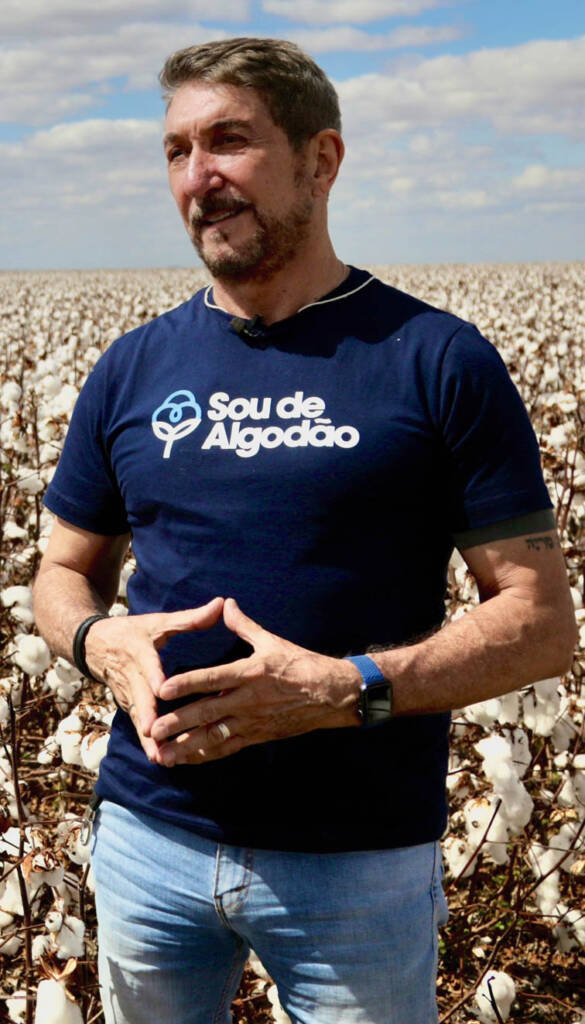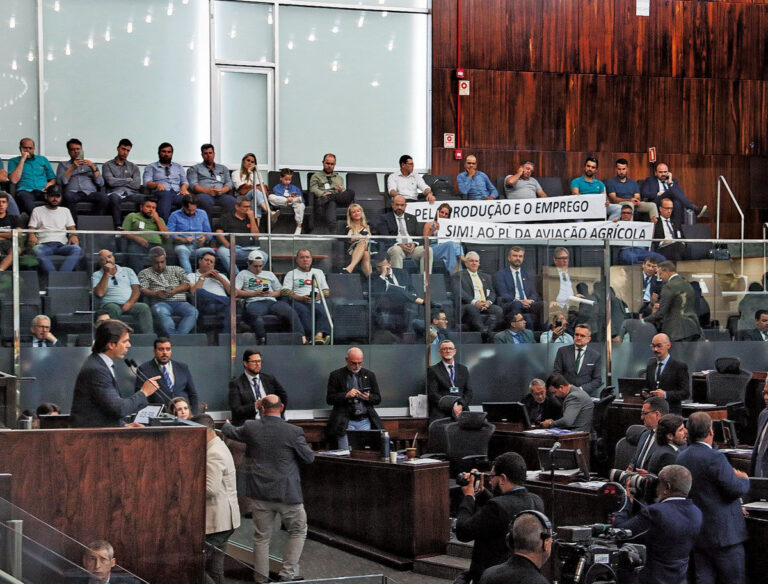“Biologicals in every possible use and chemicals only when necessary”. The quote from the director of Biological Products from CropLife Brazil, Amália Borsari, reflects the advance of usage of bioinsumables in conventional farms. The rate of biological’s adoption from 2018 to 2022 increased 61.2%. The data came from a research ordered by the association, that reunites companies and institutions who work in research and technological development to agricultural production, to the S&P Global Commodity Insight and reflects a commercialized volume superior to the projections made in 2021.
A market that keeps increasing largely and that promises to raise the area flown by aeroagricultures, having in mind that the biological product requires more entrances in the farms. The farmer from Luziânia/GO, Carlos Alberto Moresco, confirms the biggest operational demand: “the bioinsumables are like vaccines, we need to make reinforcement doses, always”.
Still, he understands that it is worth adopting this new integrated technology with the synthetics. “An application with chemicals costs 100 reais, with biological, 10 reais”. Even with the cost of the aircraft, the biologicals still have his preference. “It is in the interest of the productor to make and preserve the environment”, explains Moresco. And to make it very clear, the advance use of biologicals in Brazilian farms is the search for agricultural sustainability.
Whoever saw the volume of applications with biologicals rise significantly in the last four years was the agricultural aviation operator, Mauro Moura. CEO of the Centriar Agro Aéreo and the Agro Brasil, he allocates, since 2017, one plane just to apply organics. The demand was made by a station of sugar cane from the São Patrício Valley, in Goiás (state in the central west of Brazil) who he worked for for 23 years. The goal of the company is to enhance the organical areas and to find national and international certifications to put out a new sugar in the market.
Although it is possible to decontaminate the aircraft in a way that there isn’t any residual chemical, Moura understands that the job in the station holds an aircraft only to itself. The “green plane”, as it is called the aircraft tagged with the Organic Stamp, was the highlight of the article in the September 2019 edition of this same magazine, the Agricultural Aviation Magazine (Revista AvAg). At the time, Oliveira already visualized the growth of the market to aerial applications of biologicals, not only in organic farms, but, mostly, in the conventional ones.
Product requires respect for basic application principles

To the agronomic engineer Marcelino Borges de Brito, manager of Market Development to Koppert Brazil, a Dutch company that came to Brazil in 2011, the agricultural aviation is a tool very important to the farmers to be able to use and manage with biological products. Possibility that, in his understanding, we own to the industry, that evolved and is building formulas and organisms that, in a way, the rural productor does not need to adopt a too different management style from the synthetic molecular one.
However, he warns that the producer needs to respect the application technologies’ limitations, and follow its basic principles, such as the temperature and air humidity. And he clarifies: “applying at noon is a serious problem to the drop get in its target, that would be the pest or the illness of the plant. If the drop does not get to the target, obviously the product will not deliver his full performance”.
Brito emphasizes that the biological product is effective and that the farmer noticed that with only agrochemicals he would not be able to produce more with the same productivity. There are pests that gain resistance to the synthetic molecules. “Then, the farmer saw the need to insert a biological product in the system to break the resistance of these plagues and get back to having an equilibrated niche, avoiding loss in the farm”, explains the agronomist.
Escalation of organic molecules occurred from Helicoverpa armigera

According to the director of Biological Products at CropLife, agronomist Amália Borsari, there has been a huge growth in biological products over the last five years. This movement began to accelerate in 2010/2012 with the advent of Helicoverpa armigera, a species of moth that mainly attacks grains and occurs in all regions of the country. And biologicals turned out to be the only ones capable of containing the pest.
However, the use of biologicals on crops has been on a steeper upward curve since 2000. And in the last five years it has leapt. S&P Global’s survey for the 21/22 harvest shows that the average rate of adoption of biological control has risen to 28% of the total planted area estimated by the National Supply Company (Conab), which was 85.7 million hectares. In the 2019/20 survey, the estimated average rate was 17%. However, the manager warns that there is no prospect of bio-inputs completely replacing chemicals. “They are complementary technologies,” she says. Even so, organic molecules are expected to grow more than synthetic ones in the coming years. And the reason is simple. The chemical market is already very mature. So, in proportion, a greater volume of new bio-inputs will reach the field.
The industry has been preparing for this for a long time. According to the Director of Biological Products at CropLife, there are now close to a hundred new players on the market. She’s talking about industries that have multiplied their production volume tenfold in a short period. “I have some examples of companies that have doubled their production capacity from one year to the next,” she says.
The investments are there and they are big because there is no ready-made technology. Amália explains that Brazil had to seek out knowledge in order to develop the technology. “Today, we have the largest insect industry in the world for biological control,” says the agronomist. A result that was achieved by combining experiences from the pharmaceutical and food industries, as well as adapting fermentation processes for the development of this sector.
Producers’ expectations (Source: Executive Summary Biodefensives Brazilian Market | 2021/22 Harvest – CropLife Brazil/S&P Global)
With the biodefense products:
- Greater control efficiency 29%
- Greater durability / useful life 25%
- Product formulation 21%
- Less storage requirements 14%
- Compatibility in product mixtures 8%
- Packaging 3%
- Lower cost/price 2%
With biodefense manufacturers
- Field tests showing product results 46%
- Technical support/assistance in the field 40%
- After-sales service to evaluate product results 38%
- Guidance on the correct use of products 29%
- Diversification of product portfolio 28%
- Price reduction 7%
The projection is that 75% of control by in 25 years

“Considering the rate of growth in recent years, the area under biological control in Brazil should exceed 70 million hectares.” The estimate was taken from an article signed by Brazilian Agricultural Research Corporation (Embrapa) Environment researcher Wagner Bettiol and Federal University of Lavras (Ufla) researcher Flávio de Medeiros, published in March on the unit’s website, and refers to the country’s leadership in the production and consumption of biocontrols.
The evolution of biologicals began in the 1960s, with the use of the fungus Metarhizium anisopliae to control sugarcane leafhoppers, and gained momentum in the early 2000s, with the regulation of bioproducts. It’s a process with no turning back and one that should evolve even further. “In 25 years, 75% of pest and disease control in crops will be done by biologicals,” says Bettiol. Currently, soybeans, corn, cotton and sugarcane lead the ranking of areas served by bioproducts. However, other crops are also being managed using agrochemicals and biologicals, adding to this percentage.
Reinaldo Minaré, executive director of the Brazilian Bioinputs Association, recalls that today almost all soybean crops use inoculants, which are bioinputs designed to fix nitrogen in the soil. There are other bioproducts – formulated with microorganisms and macroorganisms – and chemicals that fight pests and diseases. The manager believes that today between 28% and 30% of the total planted area in Brazil, including conventional and organic crops, receives biological treatment. “It’s a very large volume of biological applications and it’s the beginning,” he emphasizes.
Minaré draws attention to the importance of bio-inputs for improving the quality of crops and the nutritional quality of food. He points out that biologicals are one of the components of what is known as regenerative agriculture. “The set of macroorganisms, which are wasps, and microorganisms, fungi, bacteria, among others, are responsible for incorporating organic matter into the soil,” Minaré explains. These elements, together with remineralizers, or biofertilizers, and ground cover plants, replenish the soil’s microbiota, making the soil richer in nutrients. In this way, the soil itself protects the plant.
As with soya and cotton, corn producers have also embraced the use of bioproducts. The executive director of the Brazilian Association of Corn Producers (Abramilho), Glauber Silveira, believes that around 40% of crops are working with biologicals integrated with synthetics. “We still can’t control all the pests with organic molecules alone.” He believes that this is a segment that is still going to grow a lot, noting that he sees the industry moving in search of increasingly efficient micro- and macro-organisms.
In rice crops, biologicals are being used especially in seed treatment and bed bug control. According to agronomist Maurício Ferreira, who works as an agricultural consultant in the rice and soybean segment, rice crops are still beginning the process of introducing organic molecules into the treatment of crops on the farms where he works.
To read the article by the Embrapa and Ufla researchers on the use of biocontrols in Brazil, click on the link: https://www.embrapa.br/busca-de-noticias/-/noticia/79156418/artigo-como-o-brasil-se-tornou-o-maior-produtor-e-consumidor-de-produtos-de-biocontrole
With cotton, bioproducts is a matter of survival


“Biologicals are a matter of survival for cotton producers,” says the executive director of the Brazilian Association of Cotton Producers (Abrapa), agronomist Márcio Portocarrero. Long-term cultivation – 200 days between planting and harvesting – in a tropical climate like Brazil’s, makes the use of biocontrols fundamental to keeping the crop healthy and guaranteeing the certifications – such as the Better Cotton Initiative (BCI) – that make Brazilian cotton valued on the foreign market.
According to the executive, currently 20% of the planted area is treated with bio-inputs. The trend is to increasingly reduce this difference in relation to chemicals. To achieve this, Portocarrero warns that new products still need to be developed. In this sense, there is very strong work in the sector, involving the scientific community that works in cotton production. The idea is to increasingly integrate biologicals and synthetics to create a more efficient control measure.
One example of this is the 9% uptake rate of bioinsecticides in cotton to control caterpillars and nematodes in the 2019/2020 harvest. This year, use is averaging 30%. New formulations are arriving and expanding the range of options for rural producers. According to Portocarrero, even though the cost of biologicals and chemicals is the same, “the producer gains in the stability of environmental and health protection. This is the way forward,” he says.
SUGARCANE
Although there is no defined ratio between the use of biologicals and synthetics in sugarcane, as the management depends on the needs of the plant, the use of biological control by the sugar-energy sector is a widespread and consolidated practice. Renata Camargo, Sustainability Coordinator at the Brazilian Sugarcane and Bioenergy Industry Association (Unica), highlights the use of biotechnology to control the sugarcane borer and the sugarcane leafhopper.
Renata emphasizes that the sugar-energy sector has always sought a balance between production and the environment. “The sugar-energy sector is already a benchmark for agribusiness in terms of low demand for pesticides, whether of chemical origin or as a biological input,” she points out. And within this proposal, the use of agricultural aviation is an important tool, because after a certain stage of plant growth it becomes impossible to apply by land.
In addition, Renata highlights the attributes of aerial application, using airplanes or drones. According to her, the tool makes the operation safer. Among the advantages she highlights are the reduction in direct contact between the applicator and the product and the guarantee of greater control over the volume of spray applied, making the operation more efficient.










